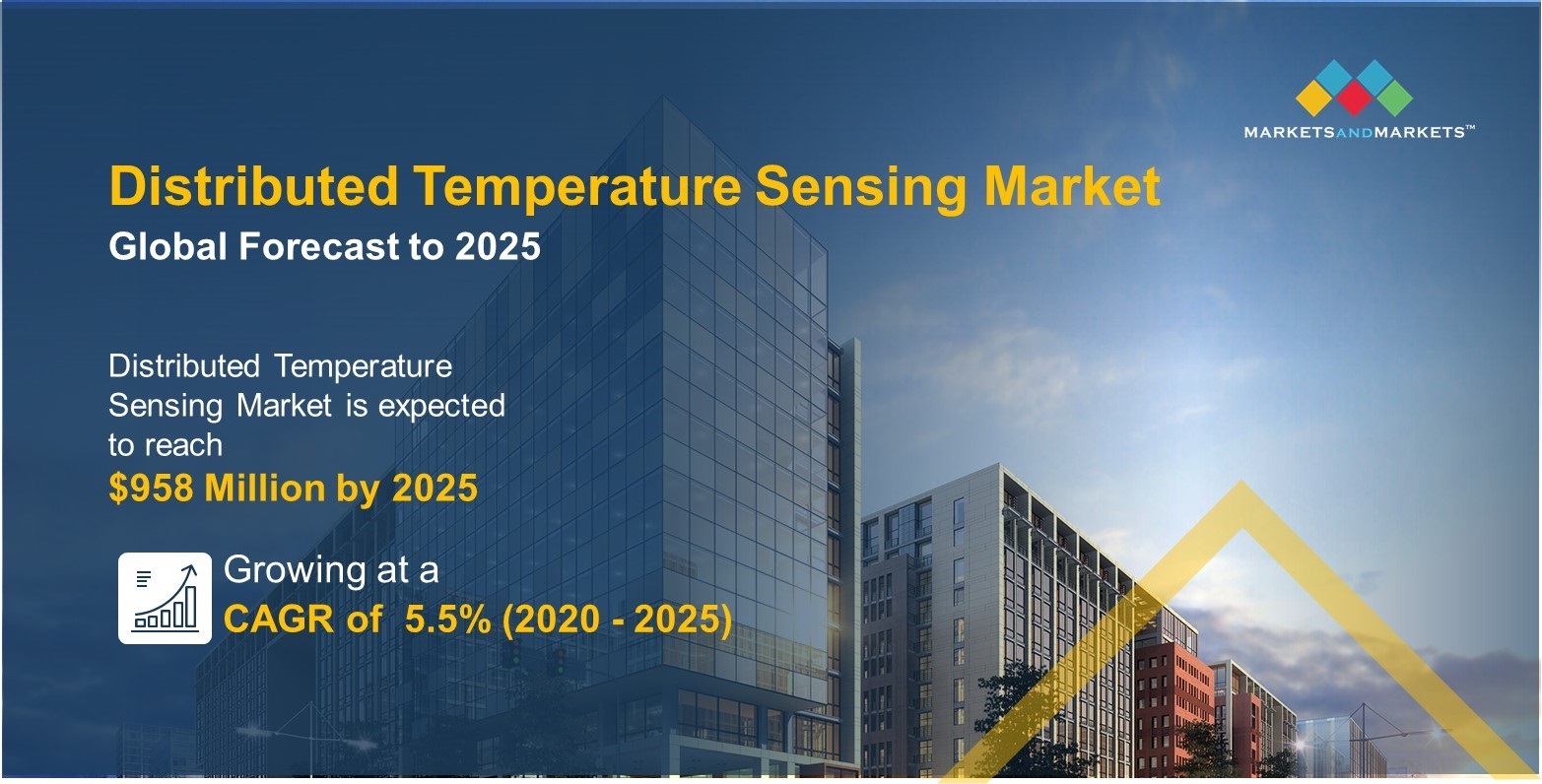According to the new research report on the “Distributed Temperature Sensing Market by Operating Principle (OTDR, OFDR), Fiber Type (Single-mode Fibers, Multimode Fibers), Scattering Method (Rayleigh Effect, Raman Effect, Brillouin Effect), Application, and Geography – Global Forecast to 2025″The global distributed temperature sensing market was valued at USD 691 million in 2019 and is projected to reach USD 958 million by 2025; it is expected to grow at a CAGR of 5.5% from 2020 to 2025. The key factors contributing to the growth of the DTS market include the increasing need for temperature monitoring for safety purposes in various applications such as oil & gas and power cable monitoring. The market growth is further driven by the ability of DTS systems to operate in harsh working environments.
• Informational PDF Brochure :- https://www.marketsandmarkets.com/pdfdownloadNew.asp?id=116007783
Browse 78 market data Tables and 48 Figures spread through 154 Pages and in-depth TOC on “Distributed Temperature Sensing Market by Application, and Geography – Global Forecast to 2025″View detailed Table of Content here – https://www.marketsandmarkets.com/Market-Reports/distributed-temperature-sensing-system-market-116007783.html
By Operating Principle: OTDR segment to propel market growth
In 2019, the optical time domain reflectometry (OTDR) segment held the largest share of the distributed temperature sensing market. The majority of DTS systems are based on the OTDR technology and hence, it is the most widely adopted technology for DTS systems. OTDR is a robust technology and is capable of providing accurate measurements with a temperature resolution of 0.01°C. This technology has been in use since the inception of DTS systems. Moreover, OTDR-based DTS systems offer advantages such as high spatial resolution, simple configuration, and high sensing accuracy. With the help of the OTDR technology, it is possible to measure temperature across long distances and temperature resolution of less than 0.01° C. Due to this property, OTDR is beneficial for a wide range of applications. The limitations of OFDR comprise limited sensing range and sensing accuracy, which restrict the deployment of OFDR-based DTS systems over long distances. Hence, OTDR-based DTS systems have a larger market size.
Additionally , the increase in shale gas exploration has boosted the growth of the oil & gas industry in the North America. Oil and gas are highly flammable, and a small safety glitch can cause damages on a large scale, which makes the use of DTS systems inevitable. The oil & gas application accounted for a major share of ~55% of the market for OTDR-based DTS systems in 2019; this trend is expected to continue till 2025.
By Fiber Type: Multimode fibers segment to grow at the fastest CAGR in distributed temperature sensing market
Multimode fibers accounted for the largest share of the market (~88%) in 2019 and are also expected to witness the highest CAGR of 5.7% during the forecast period. They are preferred in the oil & gas vertical as the multimode fiber-based systems have been tested and been in use for a long period primarily because of their ability to work reliably in harsh conditions. The use of distributed fiber optic sensors based on single-mode fibers is growing at a slower rate as compared to multimode fibers, especially in the power & utility industry. These fibers are used to cover long distances and hence, are increasingly used for power cable monitoring and process & pipeline monitoring applications. A few other advantages of multimode fiber systems include the capability of operating with substantial optical power over moderate distances inexpensively; utilizing the multiplicity of propagation modes within the fiber for sensing purposes; providing a means of sensing spectral signature changes over considerable wavelength ranges; and relatively large dimensions so improving tolerances with respect to end effects and interconnections.
By Scattering Method: Raman scattering effect accounted for the largest share of the distributed temperature sensing market
The raman scattering effect accounted for the largest market share of ~45% in 2019. Raman scattering effect is the most preferred scattering method owing to the property of maintaining a balance between the range to which it can sense physical parameters and the accuracy with which it can measure physical parameters. Also, the Raman scattering effect’s ability to measure only the temperature makes it the largest used scattering process in the distributed fiber optic sensor market for specific applications. Raman scattering is widely used for distributed temperature sensing (DTS) applications such as fire detection in tunnels and buildings, power cable monitoring, pipeline monitoring, oil and gas in-well monitoring, as well as geothermal/environmental applications. All these applications are creating demand in North America for DTS systems.
By Application: Oil & gas application accounted for the largest share of the distributed temperature sensing market
Oil & gas application to grow at the highest market size during the forecast period. The market for DTS systems is majorly driven by their implementation in the oil & gas sector. DTS systems can provide underground vertical thermal profiles at different depths. Using DTS systems, detection with a temperature resolution of 0.10° C and a spatial resolution of 1 meter is possible. DTS technology has become an integral part of the oil & gas industry. DTS systems help in continuous, real-time downhole monitoring to optimize the operational and economic performances of assets. This enables reservoir engineers to gain a better understanding of the injection and production dynamics, and accordingly optimizing the production and improving well recovery, which lead to improved profits. Hence, there is an increasing focus on adopting DTS technology for enhancing the productivity of brownfield operations. The analysis of the data collected by a DTS system can provide additional information on the behavior of the wells, for example, the flow volume within a particular section of the wells. Furthermore, technological advacements in oil & gas and environmental temperature sensing systems are expected to create dwmand for DTS systems in North America.
North America likely to emerge as the second-largest share holding region in distributed temperature sensing market during forecast period
North America accounted for the second-largest market share of the DTS market during the forecast period. The oil & gas and power & utility companies in North America are boosting their production and widening their distribution networks, and the manufacturers of DTS systems are using new technologies in their operations. Some of the major players in North America are Halliburton Company (US) and Schlumberger Ltd. (US), among others. RoW accounted for the largest market share in 2019. This region comprises the Middle East, Africa, and South America. Countries in the Middle East are the largest producers of crude oil in the world; the increasing use of DTS systems for various oil and gas applications is driving the growth of the DTS market in this region. With the rising global demand for energy, the oil & gas industry in this region is also going through changes and is increasingly incorporating innovative technologies in its processes and operations. Along with the oil & gas sector, North America has a widespread network of power cables to supply electricity across various regions. DTS systems help in power cable and transmission line monitoring, which allows the operators to optimize the distribution and transmission networks, thereby reducing the capital and operational costs.
Schlumberger Limited (US), Halliburton Company (US), Yokogawa Electric Corporation (Japan), Weatherford International PLC (Switzerland), Sumitomo Electric Industries (Japan), OFS Fitel (US), AP Sensing GmbH (Germany), Bandweaver Technologies (China), and NKT Photonics (Germany) are some of the key players in the distributed temperature sensing market.
Media Contact
Company Name: MarketsandMarkets™ Research Private Ltd.
Contact Person: Mr. Aashish Mehra
Email: Send Email
Phone: 18886006441
Address:630 Dundee Road Suite 430
City: Northbrook
State: IL 60062
Country: United States
Website: https://www.marketsandmarkets.com/Market-Reports/distributed-temperature-sensing-system-market-116007783.html


